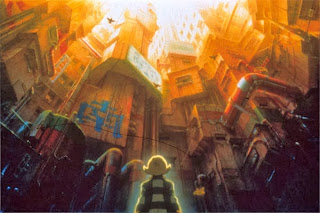Today's seminar covered much of what we have seen in the previous lectures as we haven't had a seminar for almost a month. It began with Fritz Lang's 1927 film Metropolis, and how the futuristic, technological, imposing city and its effects on the characters. This was later re-made by Japanese animator Rintaro in 2001. I'm not a particular fan of Manga as I feel it over exaggerated in every sense, and while comics do this its is done with individual characters and colourful, funny, exciting stories, where as Manga's characters often look very similar due to the style, and although it depends on the film or comic, it often uses random flashing backgrounds to the characters to unnecessarily exemplify a certain action. This said, this particular animation seemed to contain a more thought out story (as it is adapted) and the trailer hinted at the huge futuristic city being villainous in the sense that it had to be over thrown/destroyed by a set of characters. Although I find it often the city is often displayed as villainous in comics, as it is often riddled with crime (for heroes to fight) and
perpetuates the crime and violent behavior by certain citizens. Arguably cities have higher crime rates as more people live there, but also they often have more homeless people (begging in crowded areas is more opportunity for money) and housing is often cheaper in the outskirts of cities and housing estates, and people with less money become more desperate and are inclined to steal. However, I also think that huge grid like features towering above citizens can create the feeling of lees power and weakness, which frighten people. It also means quicker escape form crimes as there is far more places to hide and blend into crowds.
We also talked about the Oneiric house, (a term used by Gaston Bachelard) where the attic was a place of happy memories, the middle floors of everyday living, but the basement hides dark secrets and unwanted horrors. This reminded my on indie game Gone Home (2013), where you arrive home to find your sister missing, parents away, and must explore the house to find out whats happened. The following contain SPOILERS. The game finishes in the attic, where it is revealed that your sister, after falling in love with a girl who desperately wanted to join the army, backed out due to their love and you sister has gone to pick her up, so its a very happy ending, where in the attic the area the two girls would seek up to be alone and together away from their judgmental parents. The two middle floors are the everyday living space, but
through secret passages and the basement you find out the truth about your great uncle who was sent to a
mental institute, and down there you find newspaper cuttings of victims and strange contraptions. The game is a brilliant one that uses very little gameplay other than "pick up" or "flick switch" buts story and script make it one of the best I've played. It also closely follows Bachelards rule of the oneiric house exactly, and demonstrates how it works perfectly. I would highly advise this to anyone who is a fan of games, film, or any kind of storytelling.
We also looked at "architectural fear," a term used in Juhani Pallasmaa's "The Architecture of image: Exitentail space in cinema" in which describes how the architecture of a house or building can create a uneasy and scary atmosphere. We talked about how Hitchcock used this in Psycho, and Stanley Kubric did in the Shinning. The idea of a only empty house in a rural area creating a sense of loneliness and dominance among the characters in the setting. I also noticed this in the comic Hellboy: Seed of destruction (by Mike Mignola, 2002,) which was turned into the original motion picture, but the house in witch the comic was set did not appear. This was the setting for the whole comic, were strange events were happening, and a strange amount of frogs started appearing. It is described as:
"The Cavendish Hall was built about a hundred and fifty years ago by the first of the Cavendish family to come to America. Back then it stood on a high promontory commanding view of the lake and all the land around as far as the horizon. These days it swell on the way to having a swimming pool for a basement. Its been sinking since the day it was finished. Ohh and did I mention there's supposed to be a curse of the place? Not the house itself. The land. The lake. the Local Indians kept well clear of this area for a couple of thousand years before the Cavendish family arrived. You may think curses are just eye-wash, but I don't. I've seen way too much that makes me think otherwise. Way too much."
This appears on the first page of the comic, showing the locations vital part of the story. It also contains Bachelards rule, as the climax and monsters reside in the watery basements of the house. It is a tall and imposing house, displaying power across the land in it height, but as it sinks further and further into the earth it seems to become more and more sinister, violent and mysterious. Hellboy: Seed of Destruction uses influence from H.P Lovecraft and in my opinion the film, brilliant as it is, should have closely followed the comic as it is far more unique in the superhero genre, combining elements of horror and bold, sharp, eye catching, beautiful art.




No comments:
Post a Comment